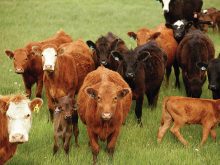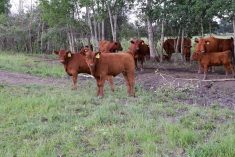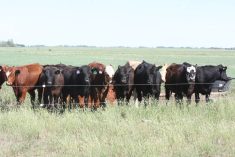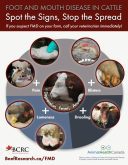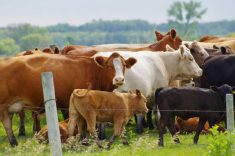Grain overload has been drastically reduced over the years thanks to nutritionists, total mixed rations and fewer incidents of accidental ingestion.
But let’s review the condition, treatment and, most importantly, the ways to prevent it.
Grain overload occurs when there is over-consumption of a carbohydrate source, most often grain. I have treated severe overload when some big cows consumed sugary water left out for bees when overwintering hives. In Eastern Canada, producers must take care when feeding overage from cereal companies.
Read Also

Pig transport stress costs pork sector
Popular livestock trailer designs also increase pig stress during transportation, hitting at meat quality, animal welfare and farm profit, Agriculture and Agri-Food Canada researcher says
When too much grain is consumed too quickly, it lowers the rumen pH, causing acidosis and diarrhea from the pooling of fluid in the digestive tract. The result is a weak, dehydrated animal that walks with a drunken stupor. Cattle may get so weak that they become downers.
Severe dehydration occurs because the body fluids are drawn into the rumen and other parts of the gastrointestinal tract. If the animal dies, a post mortem will find fluid pooled in the gastrointestinal tract and severe inflammation to the inner lining of the tract (mucosa).
[RELATED] More ‘Beef 911’ with Roy Lewis
Most cases of grain overload are easy to figure out, such as when rations are mixed up or cattle get into grain storage. Over-feeding can be a cause or, in the case of show cattle, one calf may steal from its neighbours. There have also been cases when producers weaned calves at home and put them on a creep feeder.
Many causes have been eliminated because producers use mixed rations and change them slowly, over several days, when increasing the grain component.
But even with mild grain overload, there may be a shower of bacteria into the bloodstream that is filtered by the liver, so liver abscesses result. Tylan is often used in feedlot medicine, under a prescription, to control liver abscesses.
Feedlot veterinarians are continually monitoring for liver abscesses and signs of grain overload to fine-tune the ration. Nutritionists may add buffers to ensure subclinical cases of grain overload are kept to a minimum.
The cow-calf producer rarely sees grain overload except in accidental consumption circumstances or when cull animals are fed heavier to market.
Treatment takes several forms, depending on severity. Antacids are pumped into staggery and diarrheic cases. With downers, emergency slaughter is sometimes required.
There is a way to flush grain from the rumen with a large stomach tube, allowing the grain to siphon out, but this requires lots of work, time and quick discovery of the problem.
On really valuable animals, I have seen rumenotomies in which the grain is scooped out of the rumen through a surgical excision.
In my view, the antacid pumped in or drenched in provides the most help, and if the animal still goes down and is slaughter worthy, there is no withdrawal period required for meat or milk. Due to reduced demand, some antacid products such as Oxamin, Scarlet Powder and Carmilax are no longer available in Canada. I have only found one, AVL Rumen Rx powder, although there may be others. This product helps re-establish healthy bugs in the stomach that have been killed by the acid.
Once recovered, cattle that have experienced grain overload can develop chronic bloat or fungal infection in the rumen or get liver abscesses. There is a severity scoring system for liver abscesses and livers are often condemned for consumption.
One case of grain overload may be the tip of the iceberg so scrutinize any others and, with your veterinarian, develop a protocol on when to treat, when to leave and when to slaughter. Protocols may vary for feedlot cattle or for valuable breeding stock.
A supply of antacid, a stomach tube speculum and a pump will allow quick treatment, because time is of the essence. Any time you increase grain in the ration, be especially watchful for signs of grain overload.








